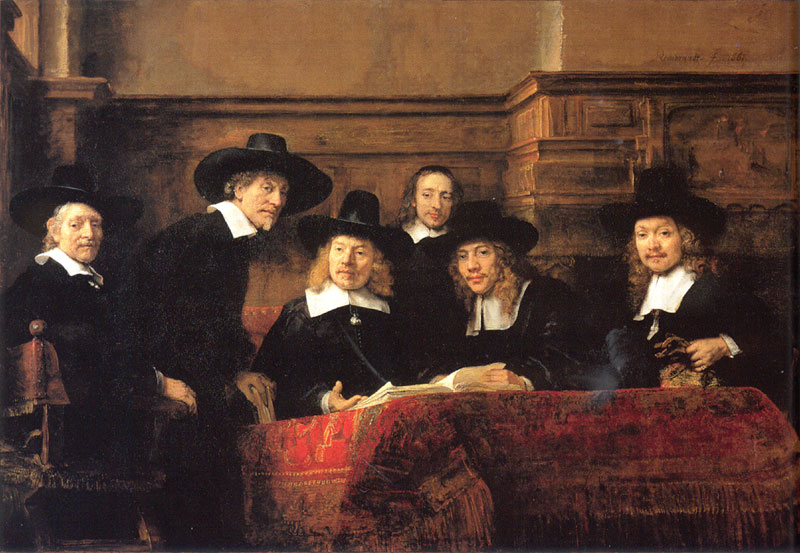Under Jan de Witt, the Dutch bested the great powers at both arms and commerce, arts and science. However, in a moment of panic they killed him and the Dutch Golden Age turned to lead. So much of what we think of as the Dutch Golden Age is conjured up by paintings: the clam of Vermeer, the serenity of De Hooch, the landscapes of Ruysdael and Hobbema, that we can forget other characteristics of the time which in particular was the tumult of trade and moneymaking.

Rembrandt. Staalmeesters. The leaders of the cloth guild look up from their work, as if interrupted at it. These austere patricians, might also be burgomasters of their towns or deputies to the states of Holland. It was into their class than Jan de Witt was born. Read More: http://membres.multimania.fr/manchicourt/Rembrandt.htm
Jan de Witt was born in 1625, the year that Spain ceased to be a danger to the small new republic with its fewer that two million people. Holland had been split between a struggle between the House of Orange who had led the fight against Catholic Spain, thereby winning the gratitude of the people and the Calvinsit leaders, who often encouraged Orange ambitions to resume the war and win back the lost southern provinces. The other side supported the regent class, which stood, in general, for the rights of the provinces, a peaceful foreign policy, free trade and religious tolerance, basically centered in Amsterdam.

Vermeer. Girl with the Red Hat. A luminous exotic quality pervades the painting done in 1667 when the Golden Age of the Dutch Republic was at its height. Read More: http://www.essentialvermeer.com/catalogue/girl_with_a_red_hat.html
The merchant-aristocrats with whom De Witt was now closely tied imposed a lasting influence on Dutch society, manners and architecture. For them, the stately town houses rose along three great new Amsterdam canals-Herrengracht, Keizergracht, and Prinsengracht- while for the lesser burghers who emulated them, smaller but similar houses were built on the streets running between. he regents married into or absorbed the old nobility, and gradually became a self-perpetuating caste, favoring their own relatives fro positions within the oligarchies. Jan de Witt’s father is alleged to have said, ” The burgher is a small fellow, and must be kept small.”
The great majority of people, though excluded from power, were satisfied with policies that avoided military entanglements of a kind the House of Orange might involve them in. The oligarchy of the regents seemed preferable to the monarchal autocracy prevalent elsewhere in Europe. The regent’s System of True Liberty received wide support, particularly from those citizens not keen members of the Reformed Calvinist faith , who believed that the regents protected them from Reformed intolerance.

Dirck van Delen. Over the States General. 1650. Spanish flags taken from the liberation wars. Read More: http://pages.uoregon.edu/dluebke/WesternCiv102/102Week8.html
By the late 1660′s the Dutch were conscious of living in a unique place in a unique time. Having beaten Spain, they now added the satisfaction of curtailing the aggressions of France and England through naval strength and cautious diplomacy. There was a feeling of security and the popular yearning for glory fostered by the House of Orange appeared appeased.
However, Dutch women did not arouse much sympathy from the English amabassador Sir William Temple. “They live with very general good frame, a certain sort of chastity being hereditary and habitual among them.” French visitors, however, felt that Dutchwomen were repressed because they found their own men cool and preoccupied with business matters; but once you got to know them, they were remarkably free. A parisian saying at the time-”to make love like a Dutchwoman”- certainly implies that the basic machinery of life in the Netherlands was in good working order.

n entire family grouped in front of portraits of ancestors that were likely done ny Frans hals but are now lost, has gathered for an at-home recital in this painting by Jan Miense Molenaar. In addition to the theme of music, certain details point to the fleetingness of time and the brevity of life: the soap bubbles blown by the boy, th clock on the wall, and even the ancestral portraits. http://en.wikipedia.org/wiki/File:Jan_Miense_Molenaer_004.jpg
Any backwardness in this respect was made up by heavy drinking. Perhaps because the quality of their water was so marginal, beer was consumed a
l meals, and between meals. Foreigners were taken aback at the size of the wine glasses used at the frequent guild banquets and drinking bouts where, with great ceremony, people got very smashed. Although the upper classes weren’t seen much in the taverns, they monopolized the consumption of Holland’s own gin, in considerable production.
Tea was taken up in the 1640′s , at first as an expensive remedy for fever. Patricians were accustomed to sampling the costly leaves in the privacy of their homes, perhaps with a few close friends. The use of tea spread from the upper classes to the bourgeoisie in the 1670′s , and the price gradually fell, but tea drinking remained a cult: pearl studded tea tables were set up in special rooms given over to its consumption; varieties of tea were discussed like wine vintages; and diffrerent methods of drinking it were debated.
ADDENDUM:
http://www.essentialvermeer.com/catalogue/girl_with_a_red_hat.html








 COMMENTS
COMMENTS




Dave,
another great post!!! Thank You for posting it!!